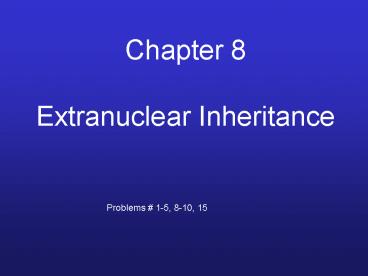Extranuclear Inheritance - PowerPoint PPT Presentation
1 / 12
Title:
Extranuclear Inheritance
Description:
Saccharomyces cerevisiae (yeast) and the petite mutation: Compare to Fig. 8.4. Segregational ... All petites. diploid zygote (usually petite) Infectious Heredity ... – PowerPoint PPT presentation
Number of Views:4343
Avg rating:3.0/5.0
Title: Extranuclear Inheritance
1
Chapter 8 Extranuclear Inheritance
Problems 1-5, 8-10, 15
2
Terms Defined
Cytoplasmic inheritance- Transmission of heredity
traits through factors in the cytoplasm.
Uniparental inheritance- Transmission of heredity
traits through only one parent.
- maternal inheritance- Uniparental transmission of
heredity traits through the mother. - paternal inheritance- Uniparental transmission of
heredity traits through the father.
3
Types of Extranuclear Inheritance
- Organelle Heredity
- Mitochondria
- Chloroplast
- Infectious Heredity
- Maternal Effect
- Genomic Imprinting
4
Organelle Heredity (chloroplast)
Chlamydomonas reinhardi and drug resistance
mt passes on chloroplast genetic material. mt-
passes on mitochondria genetic material.
Streptomycin resistance is inherited through the
chloroplast.
5
Compare to Fig. 8.4.
Organelle Heredity (mitochondria)
Saccharomyces cerevisiae (yeast) and the petite
mutation
6
Infectious Heredity
A parasite living in the cytoplasm is passed on
to the offspring through the mother (maternal
inheritance).
sensitive x normal
sensitive x normal
All sensitive
All normal
Cause Sigma (A virus found in the cytoplasm.)
7
Maternal Effect shell coiling in snails
Uniparental inheritance
DD and Dd mothers right-handed offspring
dd mothers left-handed offspring
Fig. 8.9
8
Genomic Imprinting
Whether a gene is active or not depends on if it
came from the mother or the father.
Ifg2 in mice
off
Gene from Dad ON Gene from Mom
OFF (maternally imprinted)
Fig. 4.20
9
Example of genomic imprinting in humans
Partial deletion of chromosome 15 (15q11q13).
ON
ON
ON
OFF
OFF
OFF
maternally imprinted
paternally imprinted
from mom
from dad
from dad
from mom
OFF
OFF
ON
ON
ON
OFF
Mechanism Increase methylation Turns genes
OFF Decrease methylation Turns genes ON
10
Prader-Willi / Angelman Syndrome
11
Angelman Syndrome
Prader-Willi Syndrome
12
Dosage Compensation (X-inactivation)
Humans XX female XY male
Random inactivation of one of the X chromosomes
in females during development.
Mice XX female XY male
Early in development the X from the father is
inactivated. Later, during embryonic
development, the X from the father is
reactivated and then either the X from the
mother or father is randomly inactivated.































